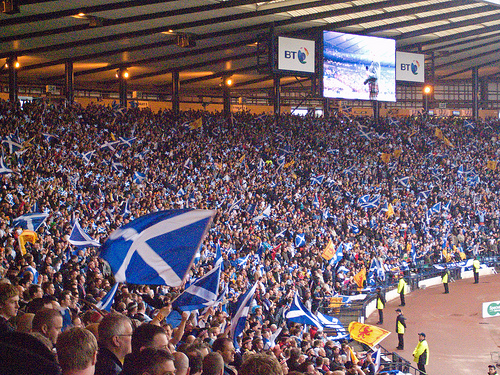
Author – Kevin McCluskie
The financial problems that have faced Scottish football in recent years have been well documented with a number of clubs enduring difficulties leading to staff and player cut backs, administration, and even liquidation in one instance. However, during the past year there have been several good news stories on the finance front as Dundee United, Aberdeen, Kilmarnock, Hearts, and others have all either announced either debt reduction deals, that they are free from long-term debt, or that they are now completely debt free. The majority of the financing that has enabled this to happen has come through investment from benefactors or the restructuring of debt into club shares; thus highlighting one of Scottish football’s main financial reliance’s, that of the benefactor. Unfortunately, not all clubs have such a generous owner willing to finance the club and, whilst Scottish football still lags behind the ‘big 5 leagues’ in terms of generating revenue through commercial and broadcast streams, the onus on financing Scottish football clubs still lies heavily with the fans. Not unsurprisingly, PricewaterhouseCoopers (PwC, 2011, 2013) reports that Scottish football clubs rely heavily upon ticket revenue, and therefore the fans, to provide its member clubs with their main source of income. PwC continue to note that should this trend continue, the knock on effect will result in a dilution of revenue into the Scottish game which will create a ripple effect as clubs will be forced to further cut their budgets, reduce wages and player numbers, and reduce spending on youth development as there will simply not be the money in the game to sustain it at its current level.
With this in mind, it is hard to overlook the important role that fans play in financing Scottish football and ensuring that it remains in a healthy position. If PwC’s elevated role of the Scottish football fan is indeed correct, and it appears that it is, then Jock Stein’s famous quote that ‘football is nothing without fans’ could have been tailor made for this scenario. With fans playing such an important role in club financing, all efforts should be made to encourage more fans to attend games and thus increase club revenue from ticket and match day sales. The following paper will assess the value of Scottish football to ascertain whether or not fans are getting value for their money.
The following analysis is made using data collated from the BBC’s Annual Price of Football Reports.
| Table 1: Price of Scottish Football | |||||||||
| Scottish Premiership 2014-15 | |||||||||
| Season tickets | Match-day tickets | ||||||||
| Club | Cheapest | Most expensive | Cheapest | Most expensive | Cheapest day out | Programme | Pie | Tea | Adult shirt |
| Aberdeen | £342.00 | £425.00 | £24.00 | £30.00 | £31.20 | £3.00 | £2.20 | £2.00 | £45.00 |
| Celtic | £287.00 | £600.00 | £23.00 | £34.00 | £29.90 | £2.50 | £2.20 | £2.20 | £53.00 |
| Dundee | £300.00 | £340.00 | £20.00 | £25.00 | £27.40 | £3.00 | £2.20 | £2.20 | £45.00 |
| Dundee Utd | £299.00 | £410.00 | £19.00 | £25.00 | £26.40 | £3.00 | £2.20 | £2.20 | £44.00 |
| Hamilton | £310.00 | £310.00 | £22.00 | £22.00 | £27.80 | £2.50 | £1.80 | £1.50 | £40.00 |
| Inverness | £200.00 | £370.00 | £16.00 | £30.00 | £20.90 | £0.50 | £2.20 | £2.20 | £45.00 |
| Kilmarnock | £297.00 | £330.00 | £17.00 | £26.00 | £22.90 | £2.50 | £1.70 | £1.70 | £40.00 |
| Motherwell | £295.00 | £420.00 | £20.00 | £27.00 | £26.70 | £3.00 | £2.00 | £1.70 | £45.00 |
| Patrick Th | £308.00 | £350.00 | £22.00 | £25.00 | £29.20 | £3.00 | £2.20 | £2.00 | £40.00 |
| Ross County | £300.00 | £360.00 | £20.00 | £26.00 | £25.80 | £2.00 | £2.10 | £1.70 | £40.00 |
| St Johnstone | £295.00 | £360.00 | £22.00 | £23.00 | £28.00 | £2.00 | £2.00 | £2.00 | £40.00 |
| St Mirren | £285.00 | £350.00 | £20.00 | £22.00 | £27.10 | £3.00 | £2.10 | £2.00 | £40.00 |
| Source: BBC Sport, Price of Football (2014) | |||||||||
From the table above, we can see that the price of attending a Scottish Premiership game in 2014/15 ranges from £16 (cheapest ticket at Inverness Caledonian Thistle) to £34 (most expensive ticket at Celtic). The cheapest day out at the football can be found at Inverness Caledonian Thistle where a match ticket, programme, pie and tea will set you back £20.90; at the other end of the scale, the most expensive day out is not surprisingly at Celtic where the same offering will cost you £40.90.
Using data gathered over a four season period (2011/12-2014/15), Table 2 shows that the price of the cheapest day out at a Scottish top flight football match has increased by just over 7% over the period covered. The average price of the cheapest season ticket has risen by approximately 28%, whereas the average price of the dearest season ticket has also risen by approximately 25% during the same period. However, the average price of the most expensive match day ticket has dropped by 7.2%. Overall, there has been a noticeable increase in the price of Scottish football during the period covered.
| Table 2: Comparison of Price of Scottish Football Data 2011/12 – 2014/15 | ||||||||
| Average Price: Season tickets | Average Price: Match-day tickets | Average Price: Miscellaneous | ||||||
| Season | Cheapest | Most exp | Cheapest | Most exp | Cheapest day out | Programme | Pie | Tea |
| 2011/12 | N/A | N/A | £18.92 | £29.00 | £25.14 | £2.58 | £1.88 | £1.75 |
| 2012/13* | £228.91 | £307.45 | £19.18 | £25.82 | £25.56 | £2.45 | £1.98 | £1.87 |
| 2013/14 | £284.58 | £394.17 | £19.83 | £26.50 | £26.34 | £2.50 | £2.08 | £1.93 |
| 2014/15 | £293.17 | £385.42 | £20.42 | £26.25 | £26.94 | £2.50 | £2.08 | £1.95 |
| *2012/13 only includes data from 11 teams as Hibernian did not supply any. | ||||||||
| Source: BBC Sport | ||||||||
Attendance at flight games in Scotland during this period have been somewhat unpredictable with average attendances yo-yoing quite significantly year by year. The sizeable drop in attendance in 2012/13 from 2011/12’s period high, can for the most part be explained by this being the first season after Rangers’ liquidation and subsequent re-emergence in the fourth tier of Scottish football. Without the 40,000+ fans who regularly attended matches at Ibrox during the previous season, 2012/13 was always likely to suffer a noticeable decrease in average attendance. 2013/14 saw the average attendance rise to 10,183, thus proving that there was interest in the Premier league, even without Rangers presence. However, 2014/15 has, quite surprisingly, given the high level of competitiveness on show, seen a period low average attendance of just 8,628. Arguably this decline could be attributed to neither Hearts nor Hibernian being part of the league and their large fan bases being lost to the leagues attendance levels. With Hearts in the Premiership next season, the average match attendance is likely to yo-yo in an upwards trajectory once again.
[1] At the time of writing Rangers were due to face Motherwell in the promotion/relegation Play-Off final to determine who would take up the final remaining spot in next season’s league table.
| Table 3: Average Attendance | |
| Season | Attendance |
| 2011/12 | 13,861 |
| 2012/13 | 9,871 |
| 2013/14 | 10,183 |
| 2014/15 | 8,628 |
| Source: ESPNFC.com | |
Scotland vs. Europe
The price of watching football in Scotland may be on the rise, but how does it compare with following football in other countries across Europe?
| Season Ticket | Match Day Ticket | |||
| League | Cheapest | Most Expensive | Cheapest | Most Expensive |
| Germany | £109.00 | £823.00 | £8.20 | £73.40 |
| Spain | £126.00 | £268.10 | £24.68 | £121.87 |
| Italy | £? | £? | £14.50 | £92.20 |
| England | £275.00 | £1,995.00 | £15.00 | £126.00 |
| Scotland | £200.00 | £600.00 | £16.00 | £34.00 |
| Source: Scottish Fans (2014) & BBC Sport (2014) | ||||
When compared to Germany, Spain, Italy, and England, season ticket prices in Scotland are somewhat midrange in price. The cost of both the cheapest season ticket and cheapest match day ticket in Scotland are amongst the highest recorded in the sample used in Table 4, however conversely, both the most expensive season ticket and match day ticket are in the lower half of the sample. In fact, the most expensive match day ticket in the Scottish Premiership is £37.40 cheaper than the next closest. When compared to Europe’s ‘big football nations’, Scottish football represents reasonable value for money in terms of pure price versus price; however, the bigger leagues have a better standard of player and therefore any overall value for money comparison based on price and playing talent is wholly subjective.
| Table 5: Price of Football (Comparable Leagues) | |||
| Match Day Ticket | |||
| League | Club | Cheapest | Most Exp |
| Belgium | Club Brugge | £12.30 | £49.20 |
| Standard Liege | £13.10 | £35.30 | |
| Netherlands | Ajax | £16.00 | £64.00 |
| Feyenoord | £19.30 | £39.80 | |
| PSV | £20.50 | £49.20 | |
| Sweden | Malmo | £12.67 | £35.74 |
| AIK | £7.24 | £45.25 | |
| IFK | £4.52 | £10.86 | |
| Scotland | Celtic | £23.00 | £34.00 |
| Aberdeen | £24.00 | £30.00 | |
| Dundee Utd | £19.00 | £25.00 | |
| Source: Scottish Fans (2014) & BBC Sport (2014) | |||
Table 5 perhaps provides a better analysis of value for money associated to the price of Scottish football, as it compares ticket prices of comparable clubs from leagues of a similar standard to that of the Scottish Premiership. From the data available for the clubs selected for this sample, we can see that the price of attending a Scottish Premiership match is roughly the same as that of attending a top-flight match in Belgium, Sweden, and the Netherlands. While the price of the cheapest match day ticket in Scotland is generally higher than in Belgium and Sweden, the price of the most expensive match day tickets in the Scottish Premiership are markedly cheaper than those from the other selected clubs (with the exception of IFK Goteborg). Therefore, it would appear that the price of Scottish Premiership football is fair when compared to that of leagues of a similar standing in the game. The notable exception being that the cost of cheapest tickets may be on the expensive side when compared to those of clubs in Belgium, Sweden, and the Netherlands.
How else can we measure value for money?
Football is part of the entertainments industry therefore, as well as going to watch our team win, we also attend games to be entertained. As the Scottish Premiership is not one of European football’s super powers, it is highly unlikely that the top players will choose to play here. This does not mean that good players do not play in Scotland, they do, but it means that we cannot use the number of ‘star’ players in the league as a means of assessing whether it represents value for money for the fans. One way that we can assess this is to consider the number of goals scored per £ spent. Football is all about scoring goals therefore it stands to reason that we want to see as many (for our own team) as possible, thus raising the hypothesis that the more goals scored by the home team, the more value for money a season ticket for that club becomes.
| Table 6: Price per goal 2014/15 | |||||
| Price per Goal | |||||
| Club | Cheapest Season Ticket | Most exp Season Ticket | Home Games | Home Goals | Home Goals per Game |
| Aberdeen | £10.69 | £13.28 | 19 | 32 | 1.68 |
| Celtic | £5.74 | £12.00 | 19 | 50 | 2.63 |
| Dundee | £12.00 | £13.60 | 20 | 25 | 1.25 |
| Dundee Utd | £9.34 | £12.81 | 19 | 32 | 1.68 |
| Hamilton | £10.33 | £10.33 | 19 | 30 | 1.58 |
| Inverness | £6.90 | £12.76 | 19 | 29 | 1.53 |
| Kilmarnock | £12.91 | £14.35 | 18 | 23 | 1.28 |
| Motherwell | £12.83 | £18.26 | 19 | 23 | 1.21 |
| Patrick Thistle | £9.63 | £10.94 | 19 | 32 | 1.68 |
| Ross County | £14.29 | £17.14 | 19 | 21 | 1.11 |
| St Johnstone | £15.53 | £18.95 | 19 | 19 | 1.00 |
| St Mirren | £20.36 | £25.00 | 19 | 14 | 0.74 |
| Source:SPFL (2015) | |||||
Table 6 shows that, perhaps unsurprisingly, the most value for money adult season ticket in the past season can be found at Celtic Park where those who purchased the cheapest tickets were treated to 2.63 ‘home’ goals per game, at a cost of £5.74 per goal. Fans of the two Thistles, Inverness and Partick, were the only other clubs whose fans paid less than £10 per home goal, £6.90 and £9.63 respectively. In terms of value for money on the dearest season tickets, it is Hamilton fans who have fared best paying £10.33 per home goal; Partick Thistle were the next best at £10.94 per home goal.
At the other end of the scale, relegated St. Mirren were the least rewarding side with their fans having to pay between £20.36 and £25 per ‘home’ goal depending on the season ticket bought. They were also the only fans in the league to see their side average less than 1 goal per home game over the course of the season.
Points per game
A further barometer of value for money can also be measured in points per game. As is to be expected, champions Celtic had the highest points per home game ratio of all teams in the league averaging 2.47 points per game. Therefore, Celtic fans spent between £6.11 and £12.77 per home point this season, depending on the price of their season ticket. However, it was fans of Inverness Caledonian Thistle who had the best return for points on season ticket spend; their fans spent between £5.56 and £10.28 per home point depending on the season ticket purchased, witnessing their heroes return 1.89 points per home game.
Fans of St. Mirren were once again short-changed when considering price per point, spending between £25.91 and £31.92 per home point; similar with goals per game, they were the only fans whose team averaged less than 1 point per home game, recording a measly 0.58 points per home game.
Value for money is of course subjective and many other factors such as emotional attachment and success on the pitch play a part in helping supporters decide whether or not they have received value for money throughout the course of the season. It is also debateable whether or not supporters actually look for value for money as attendances have remained fairly stable for most clubs, regardless of performance; the die-hard fans will always come back again next year. Tables 6 and 7 do however present some interesting findings on the issue of value for money.
| Table 7: Price per point 2014/15 | |||||
| Price per Point | |||||
| Club | Cheapest Season Ticket | Most exp Season Ticket | Home Games | Home Points | Points Per Game |
| Aberdeen | £8.77 | £10.90 | 19 | 39 | 2.05 |
| Celtic | £6.11 | £12.77 | 19 | 47 | 2.47 |
| Dundee | £13.04 | £14.78 | 20 | 23 | 1.15 |
| Dundee Utd | £7.87 | £10.79 | 19 | 38 | 2.00 |
| Hamilton | £10.33 | £10.33 | 19 | 30 | 1.58 |
| Inverness | £5.56 | £10.28 | 19 | 36 | 1.89 |
| Kilmarnock | £13.50 | £15.00 | 18 | 22 | 1.22 |
| Motherwell | £11.35 | £16.15 | 19 | 26 | 1.37 |
| Patrick Thistle | £11.00 | £12.50 | 19 | 28 | 1.47 |
| Ross County | £14.29 | £17.14 | 19 | 21 | 1.11 |
| St Johnstone | £10.17 | £12.41 | 19 | 29 | 1.53 |
| St Mirren | £25.91 | £31.82 | 19 | 11 | 0.58 |
Can we attract more fans?
While it is very possible that we are currently at saturation point in terms of attendance levels, it is still in the interests of clubs to look at ways in which they can increase match day attendance; this is especially the case due to the importance of ticket sales on club finances.
As previously identified, the average Premiership attendance from 2013/14 was 10,183. The average Premiership stadia capacity during that season was 17,410 meaning that on average there were 7,227 empty seats per game, in other words, stadia were only, roughly, 58% full on a match day. The season just passed did not fare any better. The final season average attendance was recorded at 8,628 and, while average stadia capacity may have dropped to 15,830, it still equates to an average of 58.5% of seats lying empty on a weekly basis. With match day income being the main source of income to clubs, this down turn in attendance will ultimately have a negative effect on club finances. This is clearly not a welcome scenario and, while next season’s attendances should, in theory, be up on this season, it may well still be necessary for clubs to consider some of the following creative initiatives aimed towards getting fans back into the grounds;
- Free second ticket for season book holders;
- Kids go free;
- Pay what you want;
- Consultation with fans over pricing; and
- Free tickets for the unemployed.
While none of the above initiatives can guarantee increased ticket sales, higher attendance, or revenue through match day spend, they do serve to provide food for thought and possible solutions to the current problem of half-empty stadia. Increasing the perceived value for money aspects of the game such as the number of ‘home’ goals scored per game might help as well, but that is far easier said than done.
Showing initiative may be the way forward for Scottish football, in ensuring that the game not only remains popular, but grows – both in terms of interest and its’ financial strength. It is folly to compare Scottish football to stronger leagues across Europe and therefore exploring non-traditional methods of engaging with supporters and encouraging them to attend matches mote often may be the most fruitful approach. What is for certain, is that there is much work to be done to increase the popularity of Scottish football and to provide greater value for money.
Kevin McCluskie is a researcher for Sporting Chance and a Masters graduate from the University of Stirling. He has previously conducted research for Supporters Direct Scotland – focusing primarily on disability access in Scottish football.










